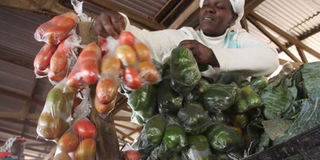Why not pack your fruits and veges?

Cecelia Wambui sells vegetables at Naromoru market in Nyeri county on April 9, 2015. PHOTO | JOSEPH KANYI
What you need to know:
- Pre-packs are designed as portion specific. They are made for a certain number of consumers such as two piece packs or family pack containing portions for a minimum of four people.
- The package is then sealed and labelled displaying the legal requirements. Pre-packing should be carried out in a clean facility using sanitised utensils.
Consumers are demanding more convenient vegetable products that are easy to prepare and save time.
Farmers should, therefore, take advantage of the changing lifestyles to earn higher returns.
One way to capitalise is by pre-packing fruits and vegetables before taking them to the market.
Pre-packing involves preparing fruits and vegetables for sale with slight processing that brings about value addition, generating greater sales value than the product would otherwise attract when sold in its natural harvested form.
Pre-packing creates a convenient product that has least wastage and offers peak quality to the consumer.
Pre-packs are designed as portion specific. They are made for a certain number of consumers such as two piece packs or family pack containing portions for a minimum of four people.
Standardised weights using calibrated electronic digital scale are used to regulate the packages of the pre-packed vegetables.
Basic pre-packing is the most straight forward way of doing it, with simple steps applied in which a fruit or vegetable is sorted, weighed and then packed.
Complex procedures that are applied depending on the end product in pre-packing include shredding, slicing, grating, cubing, chopping, whole cleaned top and tailed baby vegetables, topping and tailing, trimming and spin drying for leafy vegetables and portioning into florets for crops such as broccoli and cauliflower.
Prior to these processes, sort and wash the produce thoroughly in water. Washing is done to remove foreign matter such as soil, particularly for fruits and vegetables that have to be peeled beforehand.
FREE OF GERMS
Some markets that employ particular standards may dictate the use of a sanitiser in the final rinse water to ensure the product is free of germs.
Shredded vegetables are then weighed to a standardised size and packed in either plastic bags or punnets.
The package is then sealed and labelled displaying the legal requirements. Pre-packing should be carried out in a clean facility using sanitised utensils.
Food handlers must follow a regime of good hygiene depending on the specific obligation executed in the processing facility to prevent contamination with pathogens.
For small-scale pre-packing at home, you require stainless steel knives and slicers for shredding and slicing sukuma wiki, spinach, cabbage or courgettes. Stainless steel graters are suitable for most hard vegetables such as potatoes, carrots or sweet potatoes.
Domestic potato chipper is suitable for cubing or chipping the produce. Peeling and trimming must be done with stainless steel tools to avoid produce discolouration.
The method chosen for processing should take into consideration risk of cross-contamination and shelf-life of the end product. Pre-packing caters for niche markets.
Whole baby vegetables normally appeal for a higher price for every kilo than their mature equivalent. Vegetables used for whole baby products include beetroot, carrots, zuchinni, and cabbages.
Other types of vegetable pre-pack include a variety of spinach and beetroot leaves, parsley, coriander leaves and various types of lettuce.
Ms Makau works at the Food Science Department, Egerton University.




